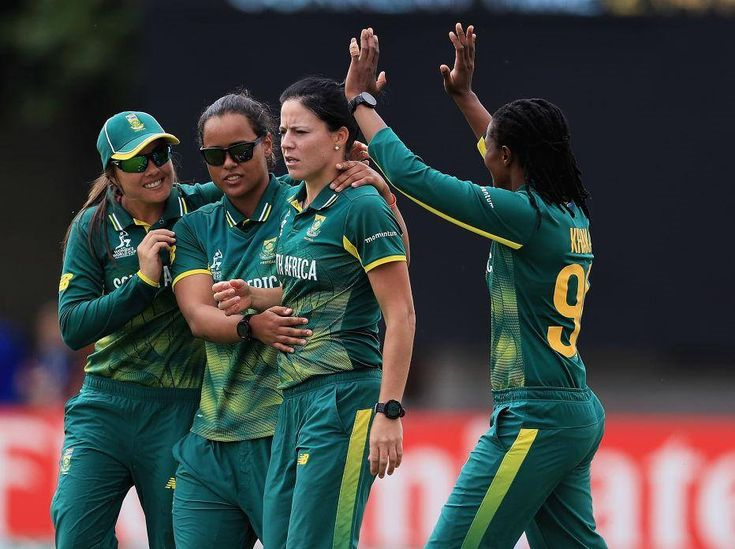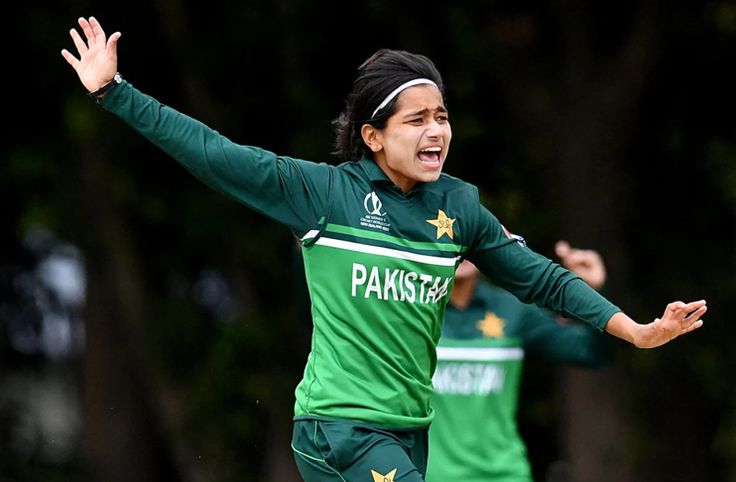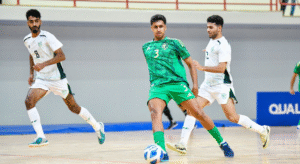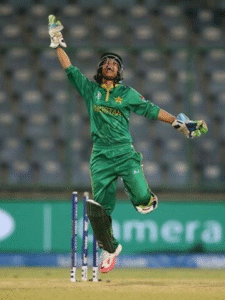
Pakistan’s Women’s World Cup campaign ended in heartbreak after a rain-affected 150-run DLS defeat to South Africa in Colombo, sealing their early exit from the tournament.
Pakistan Knocked Out After Heavy DLS Defeat in Colombo
Pakistan’s hopes of reaching the ICC Women’s World Cup 2025 semi-finals came to a bitter end on Tuesday as Fatima Sana’s side suffered a crushing 150-run defeat against South Africa under the DLS method in a rain-affected encounter at the R. Premadasa Stadium in Colombo.
The loss officially eliminated Pakistan from the tournament, marking another disappointing campaign for the Women in Green, who needed a win to stay alive in the semi-final race.
South Africa, already qualified for the knockouts, strengthened their position at the top of the table with a dominant all-round performance — while Pakistan, undone by poor bowling and difficult conditions, never managed to recover.
Persistent rain delays and wet outfield conditions only compounded Pakistan’s misery, turning what was already an uphill battle into an impossible task.

A Rain-Interrupted Match That Sealed Pakistan’s Fate
The contest began amid heavy clouds hovering over Colombo, and from the first ball, it was clear that the weather would dictate proceedings.
Pakistan won the toss and chose to field first — a decision that initially looked promising when Fatima Sana struck early, dismissing opener Tazmin Brits for a duck with a beautiful outswinger caught by Natalia Parvaiz at slip.
But from that point, it was all downhill. The first rain interruption arrived after just two overs, forcing a two-hour delay and a reduction of 10 overs per side, setting the stage for a chaotic stop-start battle.
Once play resumed, South Africa launched a relentless assault. With the pitch offering little for bowlers under the humid, slippery conditions, Pakistan’s bowlers struggled to find rhythm or control.
Wolvaardt and Luus Lead South Africa’s Batting Masterclass
After the early setback, South African captain Laura Wolvaardt took charge, anchoring the innings with a composed yet aggressive 90-run knock. Her partnership with Sune Luus, who contributed 61, was the backbone of South Africa’s innings.
The duo shared a 118-run stand for the second wicket, dismantling Pakistan’s bowling plans and pushing the scoring rate well above six an over.
Their combination of calm shot selection and opportunistic hitting frustrated Pakistan’s bowlers, who failed to capitalize on fleeting chances.
By the time both departed, South Africa had already crossed the 200-mark, setting the stage for a late onslaught.
De Klerk and Kapp Turn Up the Heat
With the foundation set, South Africa’s middle order went into overdrive. Marizanne Kapp, one of the world’s premier all-rounders, and Nadine de Klerk punished Pakistan’s bowling with ruthless efficiency.
De Klerk’s explosive cameo — 41 runs off just 16 balls, including three towering sixes — showcased South Africa’s depth and confidence. Her acceleration pushed the team past the 300-run mark, eventually finishing with a formidable 312 for 9 in 40 overs, their highest-ever Women’s World Cup total.
Pakistan’s bowling lacked bite, with Fatima Sana (2-55) and Nida Dar (1-48) being the only notable performers in a largely ineffective attack.
Rain interruptions, wet balls, and slippery run-ups didn’t help either. “It was tough to control the ball,” Fatima later admitted. “After the second over and the first rain delay, it became very hard to bowl. The ball was wet, and we just couldn’t find our rhythm.”

The DLS Target Keeps Changing — and So Does Pakistan’s Hope
When Pakistan finally came out to chase, their target had been revised multiple times under the Duckworth-Lewis-Stern (DLS) method, creating confusion and pressure in the dressing room.
Initially set a daunting 302 runs in 40 overs, the target was further reduced to 234 in 20 overs after another round of rain.
For a team already struggling with batting confidence, the equation was near-impossible.
Pakistan’s chase never gained momentum. Openers Muneeba Ali and Sidra Amin fell cheaply, both victims of South Africa’s fiery pace duo Ayabonga Khaka and Marizanne Kapp. Within the first few overs, Pakistan were two down with barely any runs on the board.
Kapp, showing her class once again, ripped through the middle order, removing Omaima Sohail, Aliya Riaz, and Sidra Amin, finishing with brilliant figures of 3 for 20.
A Familiar Batting Collapse
By the 14th over, Pakistan were reeling at 60 for 4 when the rain returned once more, halting play yet again. When the game eventually resumed, the situation only worsened.
Wicketkeeper Sidra Nawaz offered brief resistance with a gritty 22 not out, but with wickets tumbling at the other end, Pakistan’s innings ended tamely at 83 for 7.
The combination of poor shot selection, inconsistent batting partnerships, and the pressure of a constantly changing target made the task insurmountable.
Captain Fatima Sana acknowledged her team’s shortcomings in the post-match presentation:
“Our bowlers didn’t perform well today. We needed to stay calmer in those situations. Credit to South Africa — they played fearless cricket and took advantage of the conditions. But it’s disappointing. We wanted to fight harder.”
South Africa Top the Table After Dominant Win
The victory not only confirmed South Africa’s semi-final berth but also propelled them to the top of the points table.
For the Proteas, everything clicked — from disciplined batting to clinical bowling. Captain Laura Wolvaardt praised her team’s effort, saying, “The girls showed a lot of character. It wasn’t easy with all the interruptions, but our focus remained on maintaining momentum. This was one of our best batting performances.”
Their consistency throughout the tournament has made South Africa a strong title contender, alongside Australia and England, who have also secured semi-final spots.
Pakistan’s Campaign: A Story of Missed Opportunities
Pakistan’s exit from the tournament is a reflection of a campaign that never quite took off.
Despite flashes of promise, the team struggled with both bat and ball in crucial moments. The early washouts — against England and New Zealand — cost valuable points, leaving Pakistan with no margin for error.
Their victories against Sri Lanka and Bangladesh were overshadowed by heavy defeats to Pakistan’s arch-rivals India, South Africa, and England.
Inconsistency, particularly among top-order batters, proved costly. Players like Muneeba Ali and Sidra Amin, who showed glimpses of form earlier, couldn’t convert starts into substantial scores when it mattered most.
The bowling, once Pakistan’s strength, lacked penetration and control in rain-affected conditions. Nashra Sandhu and Nida Dar offered experience but couldn’t stem the flow of runs against aggressive sides like South Africa.
Fatima Sana Reflects on the Tournament
As captain, Fatima Sana took accountability for the team’s performance, highlighting areas that need urgent improvement.
“This tournament has been a big learning experience for all of us,” she said. “We need to focus on building depth, improving our batting confidence, and adapting quickly to different conditions.”
Fatima, one of Pakistan’s brightest young talents, also emphasized the importance of better preparation:
“We must invest in longer camps and exposure tours. Playing against stronger teams regularly will help us grow mentally and technically.”
Her leadership, though tested, has been praised by former cricketers for its maturity.
Weather Woes and Unfortunate Timing
Rain has been an unwelcome theme in Pakistan’s campaign. Two of their previous matches — against New Zealand and England — were washed out completely, denying them critical opportunities to earn points.
The frequent interruptions also affected the team’s rhythm and momentum, with training sessions disrupted and match strategies constantly needing revision.
Cricket analyst Sana Mir, a former Pakistan captain, commented, “It’s unfortunate how weather played such a big role. But Pakistan also need to show more adaptability — the best teams find ways to win despite external challenges.”
Looking Ahead: Rebuilding for the Future
With their World Cup journey over, Pakistan now turn their focus to rebuilding and planning for the next cycle of women’s cricket.
The Pakistan Cricket Board (PCB) has already hinted at conducting a comprehensive review of the team’s performance. Discussions are expected to center around coaching changes, fitness standards, and talent scouting at the domestic level.
Experts agree that Pakistan has the talent but lacks consistency and exposure. The emergence of young players like Fatima Sana, Ayesha Naseem, and Tuba Hassan offers hope for the future — but a stronger domestic structure and more competitive fixtures will be vital.
“We have a young team with potential,” Fatima reiterated. “With more support and regular cricket, we can compete with the best.”
South Africa’s Semi-Final Momentum
For South Africa, the win consolidates their dominance in the group stage. With batters like Laura Wolvaardt, Sune Luus, and Nadine de Klerk in red-hot form, and a bowling unit led by Marizanne Kapp and Ayabonga Khaka, the Proteas look like serious title contenders.
Their ability to adapt to conditions, maintain discipline, and handle pressure moments has been key to their success.
If they carry this momentum forward, South Africa could well be on course to reach their first-ever Women’s World Cup final.
What’s Next for Pakistan
Pakistan will conclude their campaign with a final group-stage match against co-hosts Sri Lanka on Saturday — a dead rubber with no bearing on the semi-final qualification.
While the result won’t change Pakistan’s fate, it offers an opportunity to end their campaign on a positive note. Team management is expected to give younger players a chance to gain experience and confidence ahead of upcoming international fixtures.
Conclusion: Lessons Amid the Rain
Pakistan’s exit from the Women’s World Cup 2025 will be remembered not just for the rain interruptions, but for the lessons it carries.
From tactical missteps to mental lapses under pressure, the campaign exposed the gaps between Pakistan and the world’s top teams. Yet, it also revealed flashes of potential and resilience — qualities that can form the foundation of future success.
For Fatima Sana and her team, this painful exit could become a turning point. If harnessed wisely, the experience in Colombo — marred by rain and defeat — may serve as the spark for a more determined, better-prepared Pakistan women’s side in the years ahead.
Internal Linking Suggestions:
- Link “Pakistan Women’s Cricket Team” to your team profile page.
- Link “ICC Women’s World Cup 2025” to your tournament overview article.
- Link “Fatima Sana leadership” to your interview or opinion piece on her captaincy.
- Link “South Africa Women’s cricket” to your semi-final preview post.



